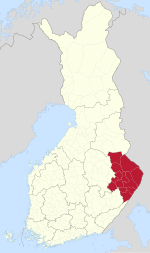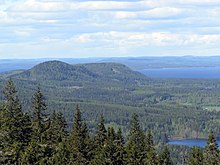North Karelia (or Northern Karelia, Finnish: Pohjois-Karjala; Swedish: Norra Karelen) is a region in eastern Finland. It borders the regions of Kainuu, North Savo, South Savo and South Karelia, as well as Russia's Republic of Karelia. It is the easternmost region of Finland and shares a 300 kilometres (190 mi) border with Russia.[2] The city of Joensuu is the capital and the largest settlement of the region.
North Karelia
| |
|---|---|
| Region of North Karelia Pohjois-Karjalan maakunta Landskapet Norra Karelen | |
 North Karelia on a map of Finland | |
| Coordinates: 63°00′N 30°00′E / 63.000°N 30.000°E | |
| Country | Finland |
| Historical province | Karelia |
| Capital | Joensuu |
| Other towns | Kitee, Lieksa, Nurmes and Outokumpu |
| Area | |
• Total | 21,584.41 km2 (8,333.79 sq mi) |
| Population (2023) | |
• Total | 162,312 |
| • Density | 7.5/km2 (19/sq mi) |
| GDP | |
| • Total | €4.814 billion (2015) |
| • Per capita | €29,174 (2015) |
| Time zone | UTC+2 (EET) |
| • Summer (DST) | UTC+3 (EEST) |
| ISO 3166 code | FI-13 |
| NUTS | 133 |
| Regional animal | Brown bear |
| Regional bird | Cuckoo |
| Regional fish | Lake salmon |
| Regional flower | Prickly rose |
| Regional stone | Soapstone |
| Regional lake | Lake Pielinen |
| Website | pohjois-karjala.fi |
North Karelia has successfully reduced chronic diseases through public health measures.[3][4] In the 1960s Finland led industrialized nations in heart disease mortality rates; North Karelia had Finland's highest incidence. In 1972 a long-term project was undertaken which targeted this risk in North Karelia.[5] The resulting improvement in public health is still considered remarkable, a model for the rest of the nation.[6] North Karelia is also known as the most sociable region in Finland.[7]

History
editThe borders of remote North Karelia were formed gradually. Important border foundations were the Treaty of Stolbovo (1617) for the eastern border and the Treaty of Teusina (1595) for the western border. The border was finally established in the Treaty of Nystad (1721), where North Karelia was separated from the "other Karelias" that remained on Russia's side.[8]
Regional identity began to form gradually in the 18th century. In 1767, the häradshövding (judge) used the name Pohjois-Karjala (North Karelia). The residents also called themselves the men of the province and drew up their own regulations in Finnish for the border guard, showing their separateness. Administratively, North Karelia belonged to different counties in the 18th century, but it had its own "North Karelia county". This self-administration set it apart from other regions. The separation was further strengthened when North Karelia was formed into its own province in 1960. North Karelia became its own region in 1994. Instead, North Karelia province was abolished in 1997 and its functions were transferred to the Eastern Finland province.[8]
Historical province
editHeraldry
editThe coat of arms of North Karelia is composed of the arms of Karelia.
Municipalities
editThe region of North Karelia consists of 13 municipalities, five of which have city status (marked in bold).
Municipalities on the map
editSub-regions
edit- Heinävesi
- Ilomantsi (Ilomants)
- Joensuu
- Juuka (Juga)
- Kontiolahti (Kontiolax)
- Liperi (Libelits)
- Outokumpu
- Polvijärvi
List of municipalities
edit| Coat of arms |
Municipality | Population | Land area (km2) |
Density (/km2) |
Finnish speakers |
Swedish speakers |
Other speakers |
|---|---|---|---|---|---|---|---|
| Heinävesi | 2,956 | 1,030 | 3 | 97 % | 0.3 % | 4 % | |
| Ilomantsi | 4,401 | 2,763 | 2 | 95 % | 0.2 % | 4 % | |
| Joensuu | 78,204 | 2,382 | 33 | 92 % | 0.1 % | 7 % | |
| Juuka | 4,188 | 1,502 | 3 | 98 % | 0 % | 3 % | |
| Kitee | 9,607 | 1,254 | 8 | 93 % | 0 % | 8 % | |
| Kontiolahti | 15,071 | 800 | 19 | 98 % | 0.1 % | 2 % | |
| Lieksa | 10,074 | 3,418 | 3 | 96 % | 0.1 % | 6 % | |
| Liperi | 11,956 | 727 | 16 | 98 % | 0 % | 2 % | |
| Nurmes | 9,016 | 2,401 | 4 | 98 % | 0.1 % | 3 % | |
| Outokumpu | 6,416 | 446 | 14 | 93 % | 0.1 % | 6 % | |
| Polvijärvi | 4,023 | 805 | 5 | 99 % | 0.1 % | 2 % | |
| Rääkkylä | 1,878 | 428 | 4 | 97 % | 0.1 % | 5 % | |
| Tohmajärvi | 3,999 | 838 | 5 | 95 % | 0.2 % | 6 % | |
| Total | 161,789 | 18,347 | 9 | 94 % | 0.1 % | 6 % |
Education
editInstitutions of higher education in North Karelia include:
Politics
editResults of the 2019 Finnish parliamentary election in North Karelia:
- Centre Party 24.46%
- Social Democratic Party 21.41%
- Finns Party 18.83%
- Green League 9.93%
- National Coalition Party 9.01%
- Christian Democrats 6.68%
- Left Alliance 5.26%
- Blue Reform 2.24%
- Movement Now 0.96%
- Seven Star Movement 0.21%
- Other parties 1.01%
In popular culture
editThe song "Pohjois-Karjala" ("North Karelia") by the Finnish pop rock band Leevi and the Leavings tells the story of an urban man who dreams of returning to his native region of North Karelia.[10] It has become such a big hit in North Karelia that it is almost perceived as a regional song.[11]
References
edit- ^ Regions and Cities > Regional Statistics > Regional Economy > Regional GDP per Capita, OECD.Stats. Accessed on 16 November 2018.
- ^ "North Karelia". English.
- ^ "The North Karelia Project: 30 years successfully preventing chronic diseases" (PDF). International Diabetes Federation. Archived from the original (PDF) on 2012-03-08. Retrieved 2012-08-06.
- ^ Willingham, Emily (2018). "Finland's bold push to change the heart health of a nation". Knowable Magazine. doi:10.1146/knowable-030718-023701.
- ^ Puska, P; Salonen, JT; Nissinen, A; Tuomilehto, J; Vartiainen, E; Korhonen, H; Tanskanen, A; Rönnqvist, P; Koskela, K; Huttunen, J (1983). "Change in risk factors for coronary heart disease during 10 years of a community intervention programme (North Karelia project)". Br Med J (Clin Res Ed). 287 (6408): 1840–4. doi:10.1136/bmj.287.6408.1840. PMC 1550066. PMID 6423038.
After the second world war cardiovascular diseases, predominantly coronary heart disease, became the leading public health problem in most of the industrialised world. Mortality statistics and other studies showed that in the 1960s the highest heart disease mortality rates were observed in Finland, predominantly in men. Within Finland the highest rates were registered in eastern Finland and were particularly high in the county of North Karelia.
- ^ "THE NORTH KARELIA PROJECT: FROM NORTH KARELIA TO NATIONAL ACTION". National Institute for Health and Welfare (Finland). Archived from the original on 2014-07-15. Retrieved 2012-08-05.
In first five years of the North Karelia Project, for example, most of the reduction in cigarette smoking took place in the first year of the programme; most hypertensive individuals who brought their blood pressure under control achieved this by the end of the third year; dietary changes took place gradually over a five-year period; and, as noted earlier, at the end of five years, a net reduction in risk-factor levels was observed. Concerning mortality, CHD incidence and mortality rates started to decline surprisingly quickly after the start of the intervention in North Karelia. In the rest of the country, a similar decline started several years later. Thus a significant net change in favour of North Karelia was observed, especially in 1974 to 1979 (Salonen et al, 1983). Thereafter, although the decline in North Karelia continued, the net decline was gradually reduced. Thus maximal difference in favour of the intervention area was observed some 5-8 years after its start (Puska et al, 1995). For cancer mortality, a net reduction in favour of North Karelia could be observed much later, i.e., 5 to 10 years after the intervention commenced.
- ^ "Ever heard the saying "quiet like a Finn"?". December 15, 2020.
- ^ a b Ojajärvi, Pentti. "Pohjois-Karjala 300 vuotta" (PDF) (in Finnish). Pohjois-Karjalan maakuntaliitto. Retrieved 2024-04-23.
- ^ a b "Area of Finnish Municipalities 1.1.2018" (PDF). National Land Survey of Finland. Retrieved 30 January 2018.
- ^ Kling, Joni (2013-10-29). "Leevi and the Leavings Top 40: #4 Pohjois-Karjala (1986)". NRGM (in Finnish). Retrieved 2021-07-02.
- ^ Jarva, Hannu. "Muhkea paketti Leevi and the Leavingsia". Karjalainen (in Finnish). Retrieved 2021-07-02.[permanent dead link]

